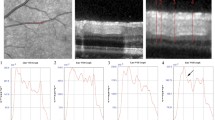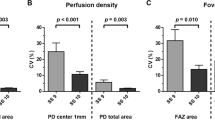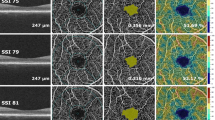Abstract
Purpose
To analyze the inter-methods agreement in arteriovenous ratio (AVR) evaluation between spectral-domain optical coherence tomography (SD-OCT) and Dynamic Vessel Analyzer (DVA).
Methods
Healthy volunteers underwent DVA and SD-OCT examination. AVR was measured by SD-OCT using the four external lines of the optic nerve head-centered 7-line cube and by DVA using an automated AVR estimation. The mean AVR was calculated, twice, separately by two independent readers for each tool.
Results
Twenty-two eyes of 11 healthy subjects (five women and six men, mean age 35) were included. AVR analysis by DVA showed high inter-observer agreement between reader 1 and 2, and high intra-observer agreement for both reader 1 and reader 2. With regard to AVR analysis on SD-OCT, we found high inter-observer agreement between reader 1 and 2, and low intra-observer agreement for reader 2 but high intra-observer agreement for reader 1. Overall, the mean AVR measured on SD-OCT turned out to be significantly higher than mean AVR measured through DVA (reader 1, 0.9023 ± 0.06 vs 0.8036 ± 0.08; p < 0.001, and reader 2, 0.9067 ± 0.06 vs 0.8083 ± 0.05; p= 0.003).
Conclusions
No inter-method agreement in AVR could be detected in the present study due to bias in measurements (shift between DVA and SD-OCT). We found significant difference in the two noninvasive methods for AVR measurement, with a tendency for SD-OCT to overestimate retinal vascular caliber in comparison to DVA. This may be useful for achieving greater accuracy in the evaluation of retinal vessel in ocular as well as systemic diseases.



Similar content being viewed by others
References
Knudston JM, Lee EK, Hubbard LD et al (2003) Revised formulas for summarizing retinal vessel diameter. Curr Eye Res 27:143–149
Klein R, Myers CE, Lee KE, Gangnon R, Klein BE (2012) Changes in retinal vessel diameter and incidence and progression of diabetic retinopathy. Arch Ophthalmol 130:749–755
Wang JJ, Liew G, Klein R et al (2007) Retinal vessel diameter and cardiovascular mortality: pooled data analysis from two older populations. Eur Heart J 28:1984–1992
Seoung-Bock L, Ki Bang U, Chul H (1998) Retinal vessel diameter in normal and primary open-angle glaucoma. Korean J Ophthalmol 12:51–59
Wong TY, Knudtson MD, Klein R et al (2004) Computer-assisted measurement of retinal vessel diameter in the Beaver Dam Eye Study: methodology, correlation between eyes, and effect of refractive errors. Ophthalmology 111:1183–1190
Goldenberg D, Shahar J, Loewenstein A et al (2013) Diameters of retinal blood vessels in a healthy cohort as measured by spectral domain optical coherence tomography. Retina 33:1888–1894
Garhofer G, Bek T, Boehm AG et al (2010) Use of the retinal vessel analyzer in ocular blood flow research. Acta Ophthalmol 88:717–722
Brueckmann A, Seeliger C, Schwefer M et al (2013) The arterio-venous ratio of retinal vessels in the first trimester as a predictor for preeclampsia. Pregnancy Hypertens 3:84–85
Terai N, Haustein M, Siegel A et al (2014) Diameter of retinal vessels in patients with diabetic macular edema is not altered by intravitreal ranibizumab (Lucentis). Retina 34:1466–1472
Heitmar R, Kalitzeos AA, Patel SR et al (2015) Comparison on subjective and objective methods to determine the retinal arterio-venous ratio using fundus photography. J Ophthalm 8:252–257
Jürgens C, Ittermann T, Vötze H, Tost F (2014) Comparison of two non-mydriatic fundus cameras to obtain retinal arterio-venous ratio. Ophthalmic Epidemiol 21:333–338
Shoukri MM (2010) Measures of interobserver agreement and reliability, 2nd edn. CRC Press, Boca Raton
Wong T, Klein R, Sharett A et al (2003) The prevalence and risk factors of microvascular abnormalities in older people: the cardiovascular health study. Ophthalmology 110:658–666
Mitchell P, Wang JJ, Wong TY, Sith W, Klein R, Leeder SR (2005) Retinal microvascular sings and risk of stroke and stroke mortality. Neurology 65:1005–1009
Yang K, Zhan SY, Liang YB et al (2012) Association of dilated retinal arteriolar calibre with early age-related macular degeneration: the Handan Eye Study. Graefes Arch Clin Exp Ophthalmol 250:741–749
Kawasaki R, Wang JJ, Rochtchina E, Lee AJ, Wong TY, Michell P (2013) Retinal vessel calibre is associated with the 10-year incidence of glaucoma: the Blue Mountains Eye Study. Ophthalmology 120:84–90
Corvi F, Querques G, La Spina C, Lattanzio R, Bandello F (2015) Dynamic and static retinal vessel analyses in patients with macular edema secondary to retinal vein occlusion. Retina 35(10):2052–2059
Author information
Authors and Affiliations
Corresponding author
Ethics declarations
The authors have no proprietary, funding, or conflicts of interest to disclose.
Informed consent was obtained from all subjects in agreement with the Declaration of Helsinki for research involving human subjects.
No animals were involved in the research.
Funding
No funding was received for this research.
Informed consent
Informed consent was obtained from all individual participants included in the study.
Conflict of interest
All authors certify that they have no affiliations with or involvement in any organization or entity with any financial interest (such as honoraria; educational grants; participation in speakers’ bureaus; membership, employment, consultancies, stock ownership, or other equity interest; and expert testimony or patent-licensing arrangements), or non-financial interest (such as personal or professional relationships, affiliations, knowledge, or beliefs) in the subject matter or materials discussed in this manuscript.
Ethical approval
All procedures performed in studies involving human participants were in accordance with the ethical standards of the institutional and/or national research committee and with the 1964 Helsinki Declaration and its later amendments or comparable ethical standards.
Rights and permissions
About this article
Cite this article
Benatti, L., Corvi, F., Tomasso, L. et al. Inter-method agreement in retinal blood vessels diameter analysis between Dynamic Vessel Analyzer and optical coherence tomography. Graefes Arch Clin Exp Ophthalmol 255, 1079–1083 (2017). https://doi.org/10.1007/s00417-017-3602-4
Received:
Revised:
Accepted:
Published:
Issue Date:
DOI: https://doi.org/10.1007/s00417-017-3602-4




